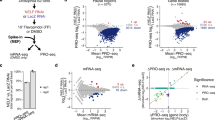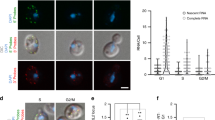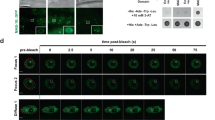Abstract
SEQUENCE-SPECIFIC DNA binding activators of gene transcription may be assisted by SWI2(SNF2)1,2, which contains a DNA-depen-dent ATPase domain3. We have isolated a human complementary DNA encoding a 205K nuclear protein, BRG1, that contains extensive homology to SWI2 and Drosophila brahma4,5. We report here that a SWI2/BRG1 chimaera with the DNA-dependent ATPase domain replaced by corresponding human sequence restored normal mitotic growth and capacity for transcriptional activation to swi2& minus; yeast cells. Point mutation of the conserved ATP binding site lysine abolished this complementation. This mutation in SW12 exerted a dominant negative effect on transcription in yeast. A lysine to arginine substitution at the corresponding residue of BRG1 also generated a transcriptional dominant negative in human cells. BRG1 is exclusively nuclear and present in a high Mr complex of about 2 & times; 106. These results show that the SWI2 family DNA-dependent ATPase domain has functional con-servation between yeast and humans and suggest that a SWI/SNF protein complex is required for the activation of selective mammalian genes.
This is a preview of subscription content, access via your institution
Access options
Subscribe to this journal
Receive 51 print issues and online access
$199.00 per year
only $3.90 per issue
Buy this article
- Purchase on Springer Link
- Instant access to full article PDF
Prices may be subject to local taxes which are calculated during checkout
Similar content being viewed by others
References
Peterson, C. L. & Herskowitz, I. J. Cell 68, 573–583 (1992).
Yoshinaga, S. K., Peterson, C. L., Herskowitz, I. & Yamamoto, K. R. Science 258, 1598–1604 (1992).
Laurent, B. C., Treich, I. Carlson, M. Genes Dev. 7, 583–591 (1993).
Kennison, J. A. & Tamkun, J. W. Proc. natn. Acad. Sci. U.S.A. 85, 8136–8140 (1988).
Tamkun, J. W. et al. Cell 68, 561–572 (1992).
Gill, G. & Tjian, R. Curr. Opin. Genet. Dev. 2, 236–242 (1992).
Zawel, L. & Reinberg, D. Curr. Opin. Cell Biol. 4, 488–495 (1992).
Stern, M., Jensen, R. & Herskowitz, I. J. Molec. Biol. 178, 853–868 (1984).
Neigeborn, L. & Carlson, M. Genetics 108, 845–858 (1984).
Winston, F. & Carlson, M. Trends Genet. 8, 387–391 (1992).
Laurent, B. C. & Carlson, M. Genes Dev. 6, 1707–1715 (1992).
Peterson, C. L., Kruger, W. & Herskowitz, I. Cell 64, 1135–1143 (1991).
Hirschhorn, J. N., Brown, S. A., Clark, C. & Winston, F. Genes Dev. 6, 2288–2298 (1992).
Laurent, B. C., Yang, X. & Carlson, M. Molec. cell. Biol. 12, 1893–1902 (1992).
Davis, J. L., Kunisawa, R., Thorner, J. Molec. cell. Biol. 12, 1879–1892 (1992).
Henikoff, S. Trends biochem. Sci. 18, 291–292 (1993).
Gorbalenya, A. E. et al. Nucleic Acids Res. 17, 4713–4730 (1989).
Travers, A. A. Cell 69, 573–575 (1992).
Troelstra, C. et al. Cell 71, 939–953 (1992).
Okabe, I. et al. Nucleic Acids Res. 20, 4649–4655 (1992).
Haynes, S. R. et al. Nucleic Acids Res. 20, 2603–2604 (1992).
Haynes, S. R., Mozer, B. A., Bhatia-Dey, N. & Dawid, I. B. Devl Biol. 134, 246–257 (1989).
Georgakopoulos, T. & Thireos, G. EMBO J. 11, 4145–4152 (1992).
Hisatake, K. et al. Nature 362, 179–181 (1993).
Sung, P., Higgins, D., Prakash, L. & Prakash, S. EMBO J. 7, 3263–3269 (1988).
Pearson, W. R. Meth. Enzym. 183, 63–98 (1990).
Flanagan, W. M., Corthesy, B., Bram, R. J. & Crabtree, G. R. Nature 352, 803–807 (1991).
Mendel, D. B., et al. Science 254, 1762–1767 (1991).
Northrop, J. P., Ullman, K. S. & Crabtree, G. R. J. biol. Chem. 268, 2917–2923 (1993).
Ullman, K. S., Northrop, J. P., Admon, A. & Crabtree, G. R. Genes Dev. 7, 188–196 (1993).
Mizushima, S. & Nagata, S. Nucleic Acids Res. 18, 5322 (1990).
Author information
Authors and Affiliations
Rights and permissions
About this article
Cite this article
Khavari, P., Peterson, C., Tamkun, J. et al. BRG1 contains a conserved domain of the SWI2/SNF2 family necessary for normal mitotic growth and transcription. Nature 366, 170–174 (1993). https://doi.org/10.1038/366170a0
Received:
Accepted:
Issue Date:
DOI: https://doi.org/10.1038/366170a0
This article is cited by
-
Heterotypic interactions can drive selective co-condensation of prion-like low-complexity domains of FET proteins and mammalian SWI/SNF complex
Nature Communications (2024)
-
Brahma-related gene 1 acts as a profibrotic mediator and targeting it by micheliolide ameliorates peritoneal fibrosis
Journal of Translational Medicine (2023)
-
Endothelial Brg1 fine-tunes Notch signaling during zebrafish heart regeneration
npj Regenerative Medicine (2023)
-
Pharmacological disruption of mSWI/SNF complex activity restricts SARS-CoV-2 infection
Nature Genetics (2023)
-
KLF4 recruits SWI/SNF to increase chromatin accessibility and reprogram the endothelial enhancer landscape under laminar shear stress
Nature Communications (2022)
Comments
By submitting a comment you agree to abide by our Terms and Community Guidelines. If you find something abusive or that does not comply with our terms or guidelines please flag it as inappropriate.



